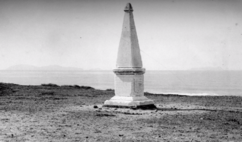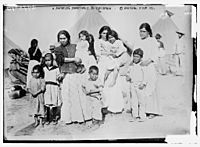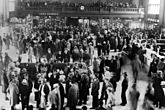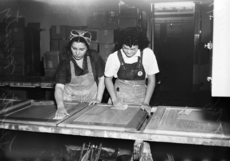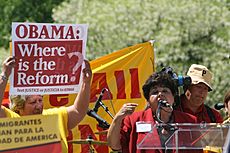History of Mexican Americans facts for kids
Mexican American history tells the story of people in the United States who have Mexican roots. This history mostly began after 1848. That year, the U.S. took over large parts of Northern Mexico. About 80,000 Mexicans living in areas like California and New Mexico became U.S. citizens. In the 1910s, many more Mexicans came to the U.S. They were escaping the Mexican Revolution and other problems in Mexico. For a long time, most Mexican Americans lived near the U.S.-Mexico border. Some also moved to the Midwest along railroad lines.
As the border became clearer, people found ways to cross. Some studies show that many immigrants enter the U.S. legally. They then stay longer than their visas allow. This has happened throughout history.
In the later 1900s, Mexican Americans spread across the U.S. This included the Midwest and Southeast. California and Texas still have the largest populations. During this time, Mexican Americans fought for their rights. They wanted fair voting, better schools, good jobs, and respect for their culture.
Contents
- Spanish Times: Early Explorers and Settlements
- Mexican Times: A New Nation Takes Over
- Early American Times: Challenges and Changes
- Late 1800s: Conflict and Change
- Early 1900s: Migration and Early Activism
- 1910s: Revolution, War, and Hardship
- 1920s: Prosperity, Prejudice, and New Voices
- The Great Depression: Hardship and Resilience
- World War II Era
- Mid-1900s: New Wars, New Workers, New Rights
- The Chicano Movement: A Fight for Identity and Justice
- The Reagan Era (1980s): New Migration and Political Voices
- 1990s: Political Shifts and Social Challenges
- Early 2000s: Growth and Activism
- 2010s: Political Strides and New Challenges
- See also
Spanish Times: Early Explorers and Settlements

The Spanish began exploring the American Southwest in 1540. Francisco Vasquez de Coronado led a group into the Rio Grande valley. Soon after, Juan Rodriguez Cabrillo explored California.
Real Spanish towns began in 1598. Juan Oñate set up a town in New Mexico. The Spanish government wanted to convert Native Americans to Christianity. They also looked for gold, but did not find much. So, their main goal became religious conversion.
The first Spanish missions (church settlements) in Texas started in the 1680s. In New Mexico, the Pueblo people fought against Spanish rule in the Pueblo Revolt. But the Spanish kept building missions. California's first permanent Spanish settlement was the Presidio of San Diego, founded in 1769 by Father Junipero Serra. This started the Mission system. It was often harsh for Native Americans.
The Spanish period ended in 1821. That is when Mexico won its independence from Spain.
Mexican Times: A New Nation Takes Over
From 1821 to 1848, the Southwest was part of Mexico. The new Mexican government found it hard to control these northern lands. They were far from Mexico City and had few people. These areas could now trade with Americans. This was not allowed under Spanish rule. Strong connections grew between wealthy Mexicans in these areas and the U.S.
Mexico's Constitution of 1824 said all Mexicans were equal. This was true no matter their race. In California, this led to big changes. The Chumash rebelled against the harsh Mission system. Wealthy California families also wanted the Missions' lands. The Mexican government agreed. They passed the Secularization Act of 1833. Mission lands were given to rich families. Native Americans then had to work on large farms called Ranchos. Conditions for them were often very bad.

Many American businessmen moved into California and Texas. They often married Mexican women. This helped them build business ties. But so many Americans moving in became a problem for Mexico. In 1835, American ranchers in Tejas rebelled. They declared Texas an independent republic. Mexico's President Santa Anna tried to stop them but lost. Mexico never accepted Texas's independence. In the new Republic of Texas, Tejanos (Mexicans in Texas) faced a lot of unfair treatment.
In 1845, U.S. President James K. Polk wanted to expand the U.S. to the Pacific Ocean. He offered to buy California and Nuevo México from Mexico. Mexico refused. Polk then sent U.S. troops into a disputed border area. This was to start a fight. After some small battles, the U.S. Congress declared war on Mexico in May 1846.
The Mexican–American War: A Fight for Land
The Mexican–American War (1846–1848) was a very important event for Mexican Americans.
Fighting and Battles

In 1846, U.S. General Stephen Kearny marched into New Mexico. He faced little resistance in Santa Fe. He put local leaders in charge of a temporary government. He promised equality under American rule.
At first, New Mexico accepted U.S. control. But within a year, many rebelled. Pablo Montoya and Tomás Romero led the Taos Revolt in 1847. They killed several American officials. The U.S. military quickly stopped the revolt.
In California, residents also fought the American army. Californios (Mexicans in California) battled U.S. forces. The U.S. Navy blocked supplies along the coast. This helped the U.S. win in California. The war ended in September 1847. U.S. General Winfield Scott captured Mexico City.
The Treaty of Guadalupe Hidalgo: New Borders, New Citizens
In 1848, the U.S. and Mexico signed the Treaty of Guadalupe Hidalgo. This treaty officially ended the war. Mexico had to give up over 525,000 square miles of land. This included California, Nevada, Utah, Arizona, and parts of other states.
The treaty promised full U.S. citizenship to Mexicans who stayed in these lands. It also said their property rights would be protected. However, a part of the treaty that protected Mexican land grants was removed. This made it hard for many Mexicans to prove they owned their land.
The treaty also classified Mexicans as "white." This was so they could become U.S. citizens. At that time, U.S. law only allowed "white persons" to become citizens. But this mostly applied to wealthy Spanish-Mexican elites. Native Americans in the new territories did not get these protections.
Early American Times: Challenges and Changes


After the war, Mexican Americans faced much violence. They also lost a lot of land. Even though the treaty promised them rights, they faced widespread unfair treatment. Mexico's president offered land and money to Mexicans. This was for those who wanted to return to Mexico. About 25% of the Mexican American population did go back. The U.S. government tried to stop this. They wanted Mexican Americans to stay. This was to create a buffer against Native American groups.
Life in the New Territories

In 1850, about 80,000 Mexican Americans lived in California, Texas, and New Mexico. Most lived in New Mexico. They mainly lived in small farming villages. In South Texas, Tejanos had a society with three main groups. Rich landowners were at the top. Small landowners were in the middle. At the bottom were peóns (laborers) and vaqueros (cowboys).

In California, most Californios lived in small farming and ranching towns. A few elite Californios held power. But most were small farmers. Native Californians faced terrible treatment. Their population greatly decreased during this time.
Losing Political Power and Land

Over time, Mexican Americans lost political power and land. This happened as their political, language, and property rights were taken away. José Manuel Gallegos was the first Nuevomexicano representative in Congress. He spoke only Spanish. His opponent argued that Gallegos shouldn't be in Congress. This was because he did not speak English. His opponent won and replaced Gallegos.
After gold was discovered in California in 1848, many people rushed to the state. This Gold Rush brought many new settlers. They wanted land. The California Land Act of 1851 created a commission. It was to settle land disputes between Californios and new Anglo settlers.
The Struggle for Land Ownership

Proving land ownership was very hard for Californios. They had to show proof of their original land grants. They also had to show they had improved the land. Many original Spanish and Mexican land grants were vague. All documents had to be translated into English. Land claim cases were very expensive. They took a long time, often 17 years. Many Californio families had to sell parts of their land. This was to pay lawyer fees.
Some Californios, like Pablo de la Guerra, fought against this unfair treatment. De la Guerra, a state senator, said the American legal system treated Mexicans as a "conquered and inferior race." Despite these efforts, most Mexican families lost their wealth and land.
In Texas, land grant issues were handled by the state. The Bourland-Miller Commission reviewed land claims. In some areas, Tejano families kept their lands. But in other parts of Texas, many Tejano land claims were not recognized.
Late 1800s: Conflict and Change
The Civil War and Mexican Americans
Mexican Americans played a big role in the American Civil War (1861-1865). Texas joined the Confederate States of America (the South). Many wealthy Mexican American families in Arizona and New Mexico supported the Confederacy. They relied on forced labor from Native Americans. However, many Mexican Americans felt angry at the U.S. for past unfair treatment. So, support was divided. In New Mexico and California, some supported the Union (the North) and some the Confederacy.
The Confederates tried to create a route to California through New Mexico. In response, many Nuevomexicanos joined the Union army. These New Mexico Volunteers defeated the Confederates at the Battle of Glorieta Pass in 1862. This battle was a turning point in the West.
In Texas, wealthy Tejano ranchers like Santos Benavides supported the Confederacy. But many working-class Tejanos fought for the Union. About 20,000 Latino soldiers fought in the Civil War.
After the War: Reconstruction Challenges

Even though Mexican Americans helped in the Civil War, they faced more unfair treatment. This was during the Reconstruction era. Many Anglo-Americans moved into New Mexico. They wanted land. New Mexico lawmakers asked Congress for help. This was to protect Nuevomexicano landowners.

In Texas, conflicts between Tejanos and white Americans led to violence. The Skinning Wars broke out in the 1870s over cattle. White groups attacked Tejano ranches. Texas Ranger Leander H. McNelly ended the conflict. He took harsh actions against Tejanos.

In West Texas, the San Elizario Salt War happened in 1877. Residents revolted when a judge tried to charge fees for collecting salt. This salt had always been free to use. The revolt was put down by Texas Rangers and the U.S. Army.
The Gilded Age: Railroads and New Tensions
The 1880s brought big changes with the arrival of the Southern Pacific Railway. El Paso, Texas, became a major center. This was for mining and construction. This boom brought new migrants. These included Mexicans, Chinese laborers, and European Americans.
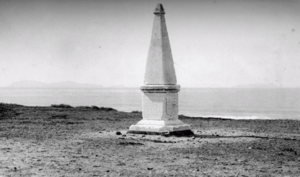
However, new immigration laws created problems. The Chinese Exclusion Act of 1882 barred Chinese immigrants. This also affected Mexicans of Chinese descent. "Chinese Inspectors" were hired at the border. This formed the early basis for the U.S. Border Patrol.
Mexican Americans continued to face unfair treatment. María Ruiz de Burton, a Californian author, wrote The Squatter and the Don in 1885. Her novel showed the struggles of a Mexican family. They were losing their land to Anglo settlers. During this time, Spanish was removed from official government use in California. Voting rules also made it harder for minority groups to vote.
The Rise of "Juan Crow" Segregation

The 1890s saw more racial conflict. In El Paso, Texas, new laws created separate neighborhoods. These were for Mexican Americans and other minority groups. These laws were called Juan Crow. They were similar to Jim Crow laws in the South. White Texans often called Mexican Americans "foreigners." This was true even if they were U.S. citizens.

Railroad and mining industries continued to grow. They attracted immigrants from Mexico. These immigrants were escaping harsh conditions. In 1891, the U.S. government created the Court of Private Land Claims. This was to settle land disputes in New Mexico, Colorado, and Arizona. Many land grants were still not confirmed.
In Texas, Catarino Erasmo Garza led the Garza Revolution (1891-1893). This was against both Mexico and the U.S. His army of Tejanos fought for "libres fronterizos" (free border people). The U.S. Army responded harshly. They burned ranches and attacked Tejano communities.
In New Mexico, Las Gorras Blancas (The White Caps) fought against powerful Anglo lawyers. These lawyers were taking over community farming lands. Las Gorras Blancas cut fences and destroyed property to protest.
Early 1900s: Migration and Early Activism
In the early 1900s, more Mexicans moved to the U.S. A new railroad connected Mexico City to the border. This made travel easier. Many came to escape economic problems in Mexico. These Mestizo (mixed ancestry) migrants faced hostility. Some Anglo Americans worried about non-white immigration. Poor living conditions were blamed on immigrants' character.
Life and Struggles in the U.S.

U.S.-born Mexican Americans faced unfair treatment. This included segregated schools and unfair legal treatment. In 1903, Mexican American and Japanese American beet farmworkers in Oxnard, California went on strike. They wanted better pay and conditions. This Oxnard strike of 1903 was one of the first organized strikes by Mexican Americans. During the strike, a laborer named Luis Vasquez was killed. The American Federation of Labor refused to support the strikers because of their race.
Border Issues and Policies
Mexico increased its actions against the Yaqui people. Many Yaquis fled to the U.S. The U.S. Army worked with Mexico to deport Yaquis. Thousands were sent back to Mexico. There, they faced violence and forced labor.
U.S. immigration officials increased rules at the border. They were concerned about Chinese Mexicans entering the U.S. by dressing in Mexican clothes. Stricter policies were adopted to prevent their entry.
1910s: Revolution, War, and Hardship
The Mexican Revolution's Impact

The Mexican Revolution (1910-1920) was a major conflict in Mexico. It started because many people were unhappy with the long rule of President Porfirio Díaz. Different groups fought for power. Leaders like Francisco I. Madero, Pancho Villa, and Emiliano Zapata emerged. The revolution led to a new Mexican Constitution in 1917.
The revolution caused many people to flee to the U.S. Between 600,000 and 1 million refugees came. This worried people in U.S. border cities. They feared the revolutionary ideas would inspire uprisings in the U.S. The Texas governor asked for U.S. troops to guard the border. The border became a militarized zone.
The revolution caused many families to move from Mexico to the U.S. They traveled on foot, by wagon, or by train.
Treatment of Mexicans in the U.S.
Life was hard for Mexican refugees and Mexican Americans. Some believed non-white people were inferior. Refugees were often denied help. Most settled in California and the Southwest. Many lived in East Los Angeles. They were often excluded from welfare programs. Mexicans found jobs in railroads, steel mills, auto factories, and farming. Mexican consulates helped organize juntas patrioticas (patriotic councils). These celebrated Mexican holidays and supported the community. [[File:Boy's home, L.A., Calif. (LOC).jpg|thumb|right|A Los Angeles Boys' home. Such homes provided care for orphaned and troubled boys.
La Matanza: A Time of Violence in Texas
The mid-1910s were extremely violent for Mexican Americans in Texas. In 1915, a document called the El Plan de San Diego was found. It called for an overthrow of American control in the borderlands. It also called for violence against Anglo Americans. After a raid on the King Ranch, Texas Rangers responded with extreme violence. They killed many Mexican and Mexican American men.
This started a period of bloodshed known as La Matanza (The Massacre). Hundreds, possibly thousands, of Mexican Americans were killed. This was by white mobs, police, and deputies. Their attackers usually faced no punishment. The Porvenir massacre was one such event.
New Immigration Rules
Anti-immigrant feelings grew stronger. In 1917, the U.S. passed the Immigration Act of 1917. This law made it harder to immigrate. It required a literacy test. It also increased taxes on immigrants. It banned more groups of people. This included people with mental illnesses and members of the LGBT community. It also banned most Asian immigrants. The U.S. Public Health Service started invasive medical inspections at the border. This led to the 1917 Bath riots. Farmers in California and Texas needed workers. They got exemptions for agricultural laborers. In Bisbee, Arizona, over 1,000 Mexican and Mexican American miners were on strike. They were forcibly deported by a mob of deputies. This was called the Bisbee Deportation.
Mexican Americans in World War I
[[File:Marcelino Serna, most decorated veteran of World War I.jpg|thumb|left|upright|Marcelino Serna, an immigrant from Mexico, was a highly decorated World War I soldier.]] The U.S. joined World War I in 1917. About 200,000 Latino Americans fought. Most were Mexican Americans. They faced unfair treatment but served in integrated units. The war effort brought a new sense of patriotic pride. A street in Silvis, Illinois, where 45 Mexican American men volunteered, was called "Hero Street." Mexican American soldiers were known for their bravery. At least eleven received the Medal of Honor. Marcelino Serna, an immigrant, received the Distinguished Service Cross for his bravery. He became the most decorated soldier from Texas.
1920s: Prosperity, Prejudice, and New Voices
The Ku Klux Klan's Rise
After World War I, anti-immigrant feelings grew. The Second Ku Klux Klan (KKK) became powerful. It was anti-Catholic and anti-immigrant. The KKK taught that Mexicans and Mexican Americans were "subhuman foreigners." They carried out violent attacks across the Southwest. The KKK was strong in Texas and California. In Dallas, the KKK controlled city politics. They wanted to close the border with Mexico. In San Diego, many city leaders were KKK members. The KKK in Southern California often attacked and killed Mexicans and Mexican Americans.
Closing the Doors: The Johnson–Reed Act
In 1921, the U.S. passed the "Emergency" Quota Act. It limited immigration based on nationality. It favored northwestern Europeans. The Johnson-Reed Act made these quotas even stricter. However, these quotas did not apply to countries in the Western Hemisphere. So, there were no caps on immigration from Mexico. This was controversial. Many nativists wanted to limit Mexican immigration. Still, U.S. officials used strict measures to limit entry from Mexico. In 1924, the Border Patrol was created. In 1929, undocumented entry became a crime.
Mexicans in Hollywood's Golden Age
In the 1920s, Mexican entertainers became famous in American pop culture. Dolores del Río was a popular actress. She starred in successful silent films like Ramona (1928). She was proud of her Mexican heritage.
Lupe Vélez was another Mexican actress who became a Hollywood star. She starred in films like The Gaucho (1927). She often played "exotic" women.
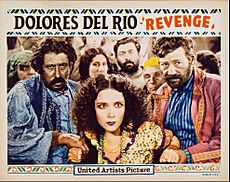
Even with Mexican stars, Hollywood often showed Latin Americans in stereotypical ways. They were shown as lazy, barbaric, or foolish. Mexican Americans worried these portrayals led to unfair treatment.
Workers and Strikes: Fighting for Fair Treatment
Mexicans filled the demand for cheap labor on the West Coast. They worked in steel mills, auto factories, and farms. California became a top agricultural state. This was thanks to the labor of Mexicans and Mexican Americans. They worked in cotton, fruit, and vegetable farming. Labor unions grew. But some, like the AFL, were anti-Mexican. When Mexicans sought better conditions, they often faced violence.
LULAC: A New Voice for Civil Rights
In 1929, the League of United Latin American Citizens (LULAC) was formed. This was in Corpus Christi, Texas. It was one of the first major Mexican American political organizations. It was started by World War I veterans. They were frustrated by unfair treatment. LULAC focused on issues like voter registration and fighting unfair laws.
The Great Depression: Hardship and Resilience
Facing Poverty and Job Loss
The Great Depression began in 1929. It hit Mexican Americans hard. Many lost jobs in agriculture and factories. White Americans, also facing unemployment, pressured employers. They wanted employers to hire only "citizens." The Hoover administration blamed Mexicans for taking jobs.

President Franklin D. Roosevelt's New Deal programs were meant to help. But many Mexican Americans were excluded. The Social Security Act of 1935 did not cover agricultural and domestic workers. These were jobs held by many Mexican Americans. Local relief programs often had residency rules. These excluded migrant workers.
Without aid, many families traveled. They searched for work. Some found help in FSA camps. These provided food and housing. These camps were often segregated. This was to protect Mexican Americans from violence.
Repatriation: Forced to Leave
During the Depression, life became very hard for many Mexicans and Mexican Americans. They lost jobs. They were denied aid. They were blamed for economic problems. Officials threatened those seeking aid with deportation. The Mexican government offered land to those who returned. This led to the Mexican Repatriation. Hundreds of thousands left the U.S. Many were pressured to leave. This was through "voluntary" programs. Welfare workers sometimes gave names of Mexicans seeking aid to immigration officials. They also paid for one-way tickets to Mexico. The INS formally deported about 82,000 Mexicans. Many more "voluntarily" left. About half of those who left were U.S. citizens.
New Deal Labor: Strikes and Organizing

Mexican American labor unions made progress. But they faced violence. In 1933, the Cannery and Agricultural Workers' Industrial Union led a massive cotton pickers' strike in California. Growers claimed the strike was a "Communist menace." They evicted strikers. They used armed groups. Federal officials denied strikers food relief. A compromise eventually ended the strike.
Luisa Moreno, an immigrant, became the first Latina to hold a national union office. Emma Tenayuca was a key leader in the 1938 San Antonio pecan shellers' strike. Nearly 12,000 workers protested wage cuts and poor conditions. Strikers were gassed, arrested, and jailed.
Politics in the Depression
Despite anti-Mexican feelings, the era saw the first Mexican American U.S. senators. Sen. Octaviano Larrazolo was elected in 1928. He died soon after. Sen. Dennis Chávez served in the House and then the Senate. He supported the New Deal. He helped bring benefits to New Mexicans.

In 1938, Luisa Moreno, Josefina Fierro, and others organized El Congreso. This group promoted workers' rights, civil rights, and Latino unity. They also defended the rights of Mexicans to live and work in the U.S. without fear of deportation.
World War II Era
Fighting for Freedom Abroad

The U.S. entered World War II in 1941. About 500,000 Mexican Americans served in the military. Most served in integrated units. Many were second-generation Americans. They grew up during the Depression's anti-Mexican feelings. The war effort brought a new sense of patriotic pride. A street in Silvis, Illinois, where 45 Mexican American men volunteered, was called "Hero Street."

Mexican American soldiers were known for their bravery. At least eleven received the Medal of Honor. Joe P. Martínez died leading a charge. Silvestre Herrera famously said, "I am a Mexican-American and we have a tradition. We're supposed to be men."
Women on the Home Front

Women played a huge role in WWII. Many Mexican American women, known as "Rositas the Riveter," worked in defense industries. They still faced prejudice. This was true even though President Roosevelt barred discrimination in defense hiring.
Mexican American women also formed community groups. These groups supported troops. The Spanish-American Mothers and Wives Association in Tucson rolled bandages. Other groups organized festivals and fought against racism.
After the War: Fighting for Rights at Home
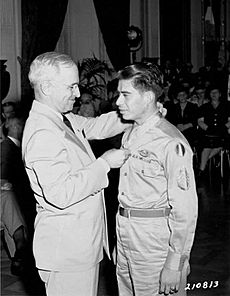
Returning Mexican American veterans faced unfair treatment. They had been heroes in Europe. But they were treated as second-class citizens at home. Macario Garcia received the Medal of Honor. But he was refused service at a Texas cafe because he was Mexican. He was arrested for protesting.
The GI Bill helped many Anglo-American families. But its benefits were unevenly applied to Mexican American veterans. Banks often denied them loans. They could only live in redlined neighborhoods. Many dropped out of college due to racism.
In 1948, Dr. Hector P. Garcia founded the American GI Forum. This was to demand equal rights for veterans. A famous case involved Private Felix Longoria. After he died in combat, his local funeral home refused to hold a wake for him. This was because he was Mexican. Garcia protested. Senator Lyndon B. Johnson arranged for Longoria to be buried at Arlington National Cemetery. This event pushed the American G.I. Forum to the forefront of civil rights.
Key Court Victories

Two major court cases in the 1940s advanced Mexican American civil rights. In Mendez v. Westminster (1947), Gonzalo and Felicitas Méndez sued school districts. This was for separating Mexican American children. School officials claimed these children were inferior. The court ruled that school segregation was unfair. This case helped end school segregation in California.
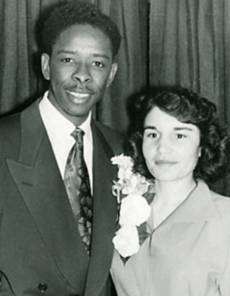
In Perez v. Sharp (1948), Andrea Pérez (Mexican American) and Sylvester Davis (African American) challenged California's ban on interracial marriage. The California Supreme Court ruled in their favor. This was the first state to overturn such a ban.
Mid-1900s: New Wars, New Workers, New Rights
Service in the Korean War

Thousands of Mexican Americans served in the Korean War (1950-1953). Many were inspired by family members who fought in WWII. Ten Mexican Americans received the Medal of Honor for their bravery. General Richard E. Cavazos became the first Mexican American four-star general.
The Bracero Program: Guest Workers from Mexico
In 1951, the U.S. formalized the Bracero Program. This program brought temporary workers from Mexico. This was to fill labor shortages, especially in agriculture. About 300,000 Braceros came each year. Many were indigenous Mexicans. The program was controversial. Some called it "legalized slavery." Labor organizers like Dolores Huerta opposed it. They said it lowered wages for Mexican Americans.
Operation Wetback: Mass Deportations

In 1954, the Eisenhower administration launched Operation Wetback. This campaign aimed to deport all undocumented people. The INS reported 1.1 million arrests. About 33,000 deportations were directly from this operation. Another 60,000 may have left voluntarily. Some Mexican American groups supported the campaign. They believed undocumented immigration hindered their ability to fit in.
Small Steps in Politics and Law

Mexican Americans made some political gains. In Los Angeles, Edward R. Roybal was the only Mexican American on the City Council. He fought against unfair laws and for fair employment. In the courts, Hernandez v. Texas (1954) was a landmark case. Pete Hernandez was convicted of murder by an all-white jury. His lawyers argued this was unfair. The Supreme Court agreed. They ruled that Mexican Americans had the right to be tried by juries that included their peers. This was a major victory against jury exclusion.
The Chicano Movement: A Fight for Identity and Justice
The 1960s: "Brown is Beautiful"
In the 1960s, many Mexican American students embraced Chicano nationalism. They called themselves La Raza (The People). They highlighted unfair treatment. They affirmed their unique racial identity. They declared "brown is beautiful." The Chicano Movement was the first large-scale Mexican American activism. Leaders like Rodolfo Gonzales in Denver and Reies Tijerina in New Mexico emphasized the U.S. government's failure to honor the Treaty of Guadalupe Hidalgo. Activists focused on unequal education and jobs. They also focused on lack of political power and police brutality. In 1968, high school students in Denver and East Los Angeles staged mass walkouts. This was to protest poor school conditions. College activists formed MEChA (Movimiento Estudiantil Chicano de Aztlán). They promoted Chicano Studies programs. The United Farm Workers (UFW), led by César Chávez and Dolores Huerta, organized strikes and boycotts. This was for grape and lettuce workers.
The 1970s: Political Action and Community Building
Bottom: Raúl Héctor Castro, Governor of Arizona (1975-1977).
Some Chicana women felt the movement wasn't addressing their issues. They formed the Comisión Femenil Mexicana Nacional in 1970. The National Chicano Moratorium March against the Vietnam War was held in Los Angeles in 1970. The La Raza Unida Party, led by José Ángel Gutiérrez, made progress in Texas politics. The Mexican American Legal Defense and Educational Fund (MALDEF) was founded in 1968. The UFW gained recognition for 50,000 field workers.
The Reagan Era (1980s): New Migration and Political Voices

Mexican migration increased in the 1980s. The Immigration Reform and Control Act of 1986 (IRCA) gave amnesty to many undocumented immigrants. But it penalized employers who hired them. Economic crisis in Mexico led to more unemployment and migration. New political leaders emerged. These included Henry Cisneros, mayor of San Antonio, and Federico Pena, mayor of Denver. Ben Fernandez ran for President in 1980. He was the first major-party Latino contender.
1990s: Political Shifts and Social Challenges
National Politics and Policies

The Immigration Act of 1990 created new immigration violations. But it also created temporary protected status (TPS) visas. President Bill Clinton appointed several Mexican Americans to his cabinet. These included Henry Cisneros and Federico Peña. However, Clinton's 1994 Crime Bill affected young Mexican American and African American men more. His signing of NAFTA had mixed effects on working classes.
Union Campaigns: Justice for Janitors
The Service Employees International Union (SEIU) launched "Justice for Janitors" campaigns. In Los Angeles in 1990, striking janitors were attacked by police. Many were undocumented immigrants. Public outrage helped them win better pay and benefits. This inspired janitors in other cities.
Los Angeles Uprising: Latino Voices Emerge
The 1992 Los Angeles uprising began after police officers were found not guilty. This was in the Rodney King beating case. Most people detained were Latino. Many were recent immigrants from Mexico and Central America. The uprising highlighted issues like police brutality and lack of city services.
Proposition 187: A Fight Against Anti-Immigrant Measures
Proposition 187 in California aimed to deny undocumented immigrants public services. These included schooling and non-emergency healthcare. Latino communities widely opposed it. Massive protests occurred. 70,000 marched in Los Angeles. The proposition passed. But it was mostly overturned by a federal judge as unconstitutional. However, it damaged Latino support for the Republican Party in California.
Early 2000s: Growth and Activism
The 2000 Census showed a large increase in the U.S. foreign-born population. Mexican immigrants made up 43% of that growth. The Southeast saw the fastest growth. Chicano activists focused on better media representation. After the 9/11 attacks in 2001, border security increased. Many undocumented workers stayed in the U.S. year-round. They worked in various jobs and sent money home.
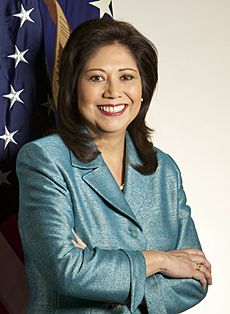
In 2005, Antonio Villaraigosa became the first Latino mayor of Los Angeles in 130 years. Mexican Americans have historically tended to vote Democratic.
2010s: Political Strides and New Challenges
The Obama Years: Progress and Deportations
Mexican Americans made electoral gains. Brian Sandoval (R-Nevada) and Susana Martinez (R-New Mexico) became governors. President Obama won strong Latino support in 2012.
Anti-immigrant sentiment rose. This was especially true in border states. Arizona's SB 1070 law allowed racial profiling. But it was partly overturned by the Supreme Court. Arizona also banned Mexican American Studies in public schools.

In 2012, President Obama announced Deferred Action for Childhood Arrivals (DACA). This allowed eligible undocumented youth to get work permits. It also gave them protection from deportation. However, the Obama administration also deported over 2.5 million people.
Gentrification: Changing Neighborhoods
Gentrification became a major issue. This was in urban Mexican American communities. In San Francisco's Mission District, rising housing costs pushed out long-time residents. New, wealthier residents moved in. This changed the character of these areas. Community groups organized to resist displacement.
The Trump Era: "Build That Wall!" and Resistance
Donald Trump's 2016 presidential campaign included strong anti-immigrant talk. This included calling for a border wall.
The Trump administration implemented a "zero tolerance" policy at the border. This led to family separations. The "Remain in Mexico" program forced asylum seekers to wait in Mexico. This created a humanitarian crisis. ICE raids increased.
Mass protests occurred against Trump's policies. The Day without Immigrants and "Families Belong Together" marches drew large crowds. Calls to "Abolish ICE" grew. Young Mexican Americans adopted a "neo-Chicanismo" identity. They focused on ethnic pride and immigrant rights.
See also
 In Spanish: Historia de los mexicoestadounidenses para niños
In Spanish: Historia de los mexicoestadounidenses para niños
- Latino Americans
- History of Mexico
- History of United States
- List of Mexican Americans
- Mexican American
- Mexico
- Spanish Americans
- History of Hispanic and Latino Americans
By state:
- Hispanos of New Mexico
- History of Mexican Americans in Texas
In other regions:



